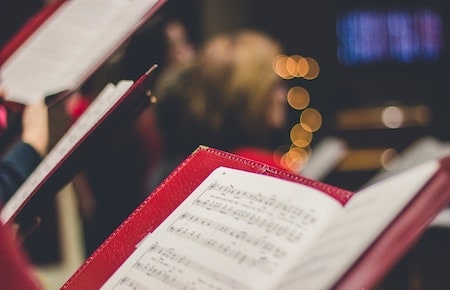
A traditional orchestra and organ arrangement of this classic hymn of gratitude and thanksgiving. Small range and moderate tempo makes it easy for congregational singing. The arrangement builds steam as it progresses, adding more orchestral instruments in each verse.
F C A

A traditional solo organ accompaniment to this well-known hymn of gratitude and stewardship. Perfect for Thanksgiving. Lyrics touch on themes of responsibility, the earth, and care of the environment.
F Eb Bb

A gentle, uplifting folk/classical version of this common Thanksgiving hymn. Cat Stevens used the same melody for his well-known song "Morning has Broken". Acoustic guitars, piano, string orchestra, and percussion. Four verses.
Bb C G

The massive final movement of Handel's Messiah, scored for SATB chorus and full orchestra, includes unison rhythm choruses, four part fugal sections, a big ending, and a four-minute Amen section that could be considered a separate movement. Trumpets and kettledrums boost the energy of this truly grand finale.
D

A flowing duet for alto and tenor leads into a glorious SATB chorus thanking God. This track comprises movements 50 and 51 of the Messiah. Orchestral accompaniment is from Handel's original score.
Eb

Movement 49 of Handel's Messiah is a short alto recitative, setting the tone (and the key) for the alto-tenor duet that follows it (O Death, Where is Thy Sting?)
Bb

A majestic, triumphant aria for bass, featuring solo trumpet and full orchestral accompaniment. Movement 48 of Handel's Messiah, it speaks of the end of the world: how the dead will be raised, and the mortal will become immortal. Quite lengthy, as practically the entire four-minute aria is repeated after a short interlude.
D

Movement 47 of Handel's Messiah is a bass recitative that serves as a noble and grand introduction to the bass aria "The Trumpet Shall Sound".
D

A dramatic SATB chorus, movement 46 of Handel's Messiah. Extremely slow and quiet sections describing death alternate with loud, upbeat sections describing resurrection. For this recording, organ quietly doubles the vocal parts in the a capella sections.
Am

A forceful, exciting aria for tenor, with lyrics describing God's wrath towards those who work against him. Orchestral direction follows the London Philharmonic recording. Movement 43 of Handel's Messiah, this aria occurs immediately before the famed Hallelujah Chorus.
Am

A brief tenor recitative, accompanied by harpsichord and strings. Movement 42 of Handel's Messiah, this functions as a short introduction to the tenor aria "Thou Shalt Break Them".
E

M ovement 41 of Handel's Messiah is a lively, energetic SATB chorus. Imitative parts and frequent modulations present an interesting challenge for any choir. One measure has been added to the beginning to establish tempo and key.
C

An exciting aria for bass soloist, movement 40 of the Messiah. Furiously bowing strings mirror the nations and kings in the lyrics, which "furiously rage together".
C

A strong, energetic SATB chorus, movement 39 of the Messiah is fairly brief. Forte all the way through, it makes a good concert opener. The orchestra follows Handel's original score.
Eb

A slow, peaceful aria for soprano with orchestral accompaniment. Movement 38 of Handel's Messiah, the lyrics praise Christians who spread peace and the good word. The slow tempo leaves room for vocal ornamentation.
Gm